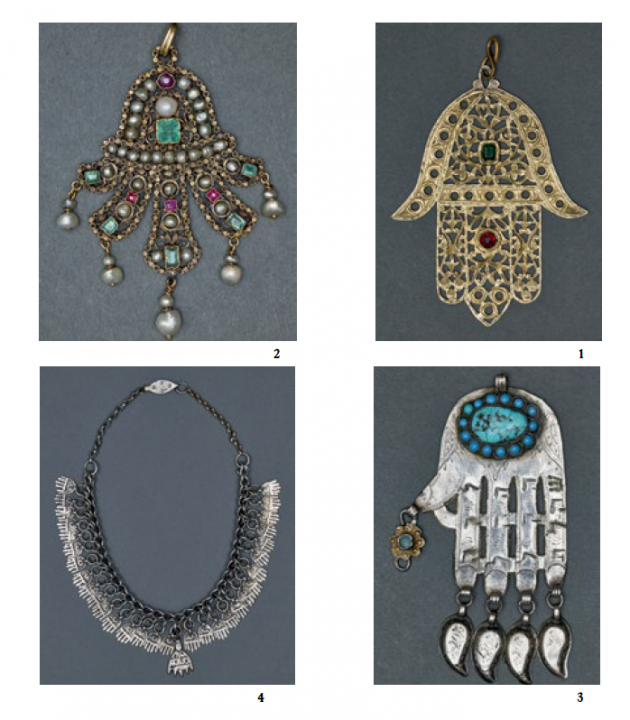The Museum for Islamic Art in Jerusalem, with a mission of promoting interfaith dialogue, has opened a “past and present” jewelry exhibit featuring a section that highlights the Jewish amuletic jewelry in the communities of the Islamic world.
According to its director, Idit Sharon, the museum serves as a multicultural bridge between the different streams of Israeli society, Arabs and Jews, while furthering dialogue based on tolerance, mutual respect and equality.
The newly opened exhibition is a prime example of this, presenting amulets made by Jewish designers living in the Arab world. Along with the amuletic jewelry, the exhibit includes European Jewish ceremonial objects, like a Sabbath lamp, a wine goblet and spice boxes.
Their aesthetic beauty, together with the faith they represent of the people who believed in their efficacy, are a gateway into the origins of the Mizrahi populations of Israel and their cultural relationship to their Muslim neighbors.
Judaica collector William Gross, who collaborated with the museum on the exhibit, offered his take on the jewelry pieces, noting that Jewish amuletic jewelry has forms and styles “often closely related to similar objects in the surrounding Muslim culture.” For example, he described the hamsah, an element against the evil eye, originated in jewelry in the 12th century among both Muslims and Jews, and continued to be used by both groups.
Gross noted that in their form and craftsmanship, “the folk art of Jews and Muslims was strikingly similar.”
From Iran is a large, elegant pendant with beautifully engraved protective “names”—around the perimeter is the 42-letter “name” formed from the initial letters of the 42 words of the prayer “Ana Bekoach.” Several other inscribed amuletic formulas appear, such as the names of the three angels, the 22-letter name, and several others formed from abbreviated sections of biblical text for general protection. Lifting the front cover reveals a mirror to reflect the evil eye back onto anyone directing it towards the bride.
A Tunisian necklace on display, made from gilded silver, includes four filigree hamsahs placed along the length of the necklace to convey protection from the evil eye. The filigree elements are attached to chains of flattened rings called recannah, a trademark of skilled Jewish goldsmiths in Tunisia.
An amulet from the Caucuses, executed in the form of a fish with niello metal work, has an inscribed Tetragrammaton with the letters on the dangling round elements forming the word argaman, a name made up of the initial letters of five powerful angels: Uriel, Raphael, Gabriel, Michael and Nuriel.
Explaining how these pieces reflect Jewish life in the Arab world, explained Sharon, “Jewish gold and silversmiths made jewelry for all parts of society from the 17th to 19th centuries in Morocco, Iran, Algeria, Iraq, Tunisia, Yemen, Ethiopia and India. During this time, most jewelers in the Arab world were Jewish, and the time was characterized by good economic relations between Jews and their Arab neighbors.”
“Through the jewelry, one can witness the relationship between Jewish and Arab artists’ dialogue in art,” she said.
According to Sharon, the fact that Jews and Muslims used shared symbols in their work exists until today. “Jewelry-making is a language that is universal and brings people together,” she said.
‘We carry our culture with us’
For this exhibition, the museum commissioned local artists and jewelers to select a jewelry piece from the museum’s collection and create their own contemporary interpretation of these historic pieces for the exhibition. Doing so offered a new lens of modern Israeli interpretations with which to view the collection.
The modern pieces are presented alongside historic Jewish, Islamic and Christian jewelry from throughout the ages. Also on exhibit are pieces of Israeli singer Ofra Haza’s jewelry and Bedouin jewelry from artists in the St. Catherine’s Monastery Region of the Sinai.
Inbar Shahak, who made one of the contemporary pieces on display, was interested in a ring from southern Morocco, topped by the form of a house with a pointed roof. Using a 3D printer, she created a similar ring that she says “raises questions about the contemporary home.”
“Everything I do today is because my grandmother taught me to sew,” said Shahak, whose grandparents, originally from Turkey and Bulgaria, immigrated to Israel.
–JNS
 Metro Voice News Celebrating Faith, Family & Community
Metro Voice News Celebrating Faith, Family & Community









